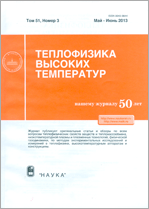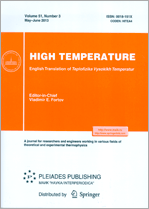|
|
Teplofizika vysokikh temperatur, 2003, Volume 41, Issue 3, Pages 347–352
(Mi tvt1661)
|
 |
|
 |
This article is cited in 1 scientific paper (total in 1 paper)
Plasma Investigations
Cluster-impact fusion of light nuclei
V. Yu. Velikodnyi, V. A. Bityurin
Joint Institute for High Temperatures, Russian Academy of Sciences, Moscow
Abstract:
A number of researchers, who performed experiments to investigate the interaction of charged clusters of heavy water $(\mathrm{D}_2\mathrm{O})_n^+$, accelerated in an electric field to an energy of $300$ keV, with a wall of deuterated materials $(\mathrm{TiD}$, $(\mathrm{C}_2\mathrm{D}_4)_n)$, revealed an "anomalously" high yield of products of the reaction $^2\mathrm{D}+{}^2\mathrm{D}$ with increasing size of clusters. It is demonstrated in this paper that the "anomalously" high yield of products of the reaction $^2\mathrm{D}+{}^2\mathrm{D}$ with increasing size of clusters may be caused by nonequilibrium effects arising as a result of collective interaction between $^2\mathrm{D}$ and heavy atoms of $\mathrm{O}$ and $\mathrm{Ti}$ by the Fermi mechanism. Based on the results of analysis of experimental data and prediction results, we suggest methods of realizing the process of fusion of light nuclei at a close-to-maximal rate at a relatively low average energy per nucleon in a cluster of about $0.005$ to $0.8$ keV. In principle, no novel breakthrough technologies are required to realize the suggested methods (standard commercially available equipment is adequate for the purpose). A characteristic feature of the suggested devices consists in their small dimensions and a relatively low value of the initial energy input, which offers possibilities for their utilization as a source of energy in flights to outer planets of the solar system and at stations on those planets.
Received: 31.07.2002
Citation:
V. Yu. Velikodnyi, V. A. Bityurin, “Cluster-impact fusion of light nuclei”, TVT, 41:3 (2003), 347–352; High Temperature, 41:3 (2003), 295–299
Linking options:
https://www.mathnet.ru/eng/tvt1661 https://www.mathnet.ru/eng/tvt/v41/i3/p347
|


| Statistics & downloads: |
| Abstract page: | 164 | | Full-text PDF : | 117 |
|





 Contact us:
Contact us: Terms of Use
Terms of Use
 Registration to the website
Registration to the website Logotypes
Logotypes








 Citation in format
Citation in format 
